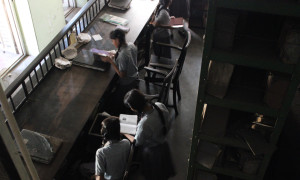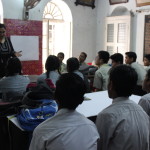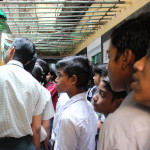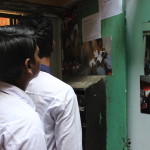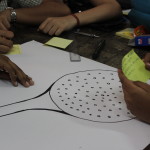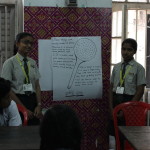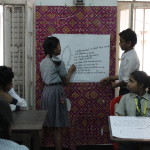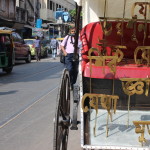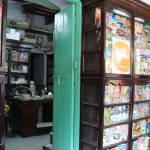Addressing educators at the Open House last year, Professor Romila Thapar spoke about the importance of questioning and ‘being suspicious’ of what one reads and teaches. She also spoke of how she references detective novels, particularly Mrs. Marple, for what is a historian, but a detective?
At History in the Making—a workshop on discovering history through everyday objects, we spoke with 25 middle school students about that very need, the importance of questioning. Being young detectives and discovering history through the world around you, not just textbooks.
The venue for the workshop was The Chaitanya Library, one of the first public libraries in Calcutta, now over 125 years old. The students—from Chowringhee High School, Oriental Seminary School, Bidya Niketan and Kailash Vidyamandir—had never seen a library like this before. Sumona showed them a few of the books, telling them how they can find out about the ‘history’ of the book by looking at the publishing details at the beginning. After a brief introduction to the Chitpur Local project—which the workshop was a part of—Sumona spoke to the students about the importance of looking beyond history textbooks and delving into the history of everyday objects. The students then went to Bidya Niketan school, where they walked through ‘ Our (Un) familiar Streets’ a trail that had been set up by the students from the school. The trail uses photographs and everyday objects that are found commonly in that area: from the school to Jorasanko Thakurbari.
Back at the library, the students played a small memory game: how many objects do they remember from the walk? They were then divided into four groups. Each group had to choose one of the objects that they had seen at the exhibition and draw it on a chart paper and using that object answer as many questions as possible about the community. Essentially, use that object as a ‘clue’ and become, for that time, detectives. This proved challenging, but with some sample questions and starting points, each of the groups was able to draw conclusions about the community. For instance, the group that chose the damru came to the conclusion that if this musical instrument was found commonly in that area, then it meant that it was a community that loved music and also, possibly, worshipped Shiva, given that the God is pictured carrying this instrument. The group that chose a kitchen appliance said that the community clearly enjoyed fried food, because the appliance is commonly used to deep-fry food.
After a break for lunch, Sumona introduced the students to the installations using poetry and everyday objects like mirrors and a hand-pulled rickshaw by architect Suhasini Kejriwal. This project combines art, in the form of poetry and objects, thereby giving a new perspective to what we see on a daily basis. The students walked with the rickshaw to Diamond Library, which again, showcases a different type of history, being a publisher of Jatra scripts.
I think the workshop gave the students an exposure to the different lenses through which history can be looked at and that it is not just about memorising dates from textbooks. Historians are after all detectives and what is more exciting than that?
–Paroma Sengupta

